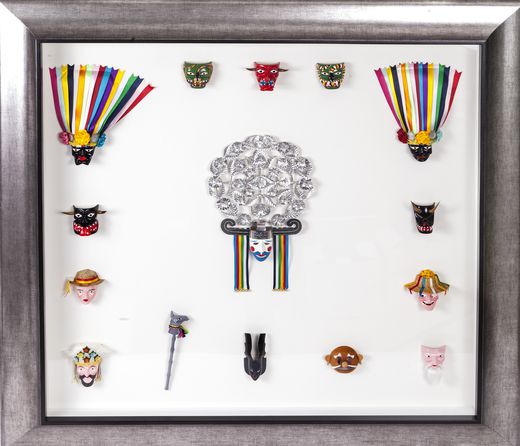
Mexico
Biography
Although Victoriano Salgado Morales has passed away, his legacy lives on through his family. He was one of Mexico's premier mask carvers whose masks were synonymous with the regional dances of Uruapan, Michoacán where he was born.
Folk dance transforms the dancer into another being. The mask permits this mutation, allowing one to host other spirits, to become one with the gods by wearing another face. The mask and the dance. Wood and rhythm.
For the fiesta in the Magdalena neighborhood where the Salgado family resides, Don Victoriano distinguished himself by the great effort he directed toward the mounting of this fiesta, as well as the traditional Christmas pageant. Now his family continues this tradition.
Now the second generation to practice this art, Victoriano's sons, Martin, Gerardo and Juan Carlos are three of the family members who take the wood into their hands, carve and mold it into the desired shape and then finally color the mask using a process known as maque.
Using either zompantle or colorin wood, Martin shapes the faces with gouges, chisels and various knives. After carving, the mask is put aside to dry for a few days and to avoid insect infestation, they place the mask in a small oven and "bake" the piece.
Another coloring technique employed is polishing the carved piece with wet sandpaper and then applying a coat of a mixture made from plaster and zinc oxide called size. When dry, this provides the background color. For a light-colored background, a powdered pigment known as igueteca is added to the mixture. For a dark background, patzicua is added, a powdered volcanic material which is black in color.
The artisans spread the size over the mask with their fingers. After drying, color is added using powdered pigments. Dried again, the mask is then polished with their bare hands or with a polishing stone. Next, it is coated with oil and polished again, followed by another coat of size and more pigment. The process is repeated over and over until the desired background is produced. When finished, the mask is rubbed with a piece of cotton. If the cotton does not pick up part of the color of the lacquer, it is ready to be decorated. First, it is given a careful polishing with a cloth dipped in linseed oil to bring out the shine of the lacquer.
When completed, the mask takes on a lifelike character.
Read more
Folk dance transforms the dancer into another being. The mask permits this mutation, allowing one to host other spirits, to become one with the gods by wearing another face. The mask and the dance. Wood and rhythm.
For the fiesta in the Magdalena neighborhood where the Salgado family resides, Don Victoriano distinguished himself by the great effort he directed toward the mounting of this fiesta, as well as the traditional Christmas pageant. Now his family continues this tradition.
Now the second generation to practice this art, Victoriano's sons, Martin, Gerardo and Juan Carlos are three of the family members who take the wood into their hands, carve and mold it into the desired shape and then finally color the mask using a process known as maque.
Using either zompantle or colorin wood, Martin shapes the faces with gouges, chisels and various knives. After carving, the mask is put aside to dry for a few days and to avoid insect infestation, they place the mask in a small oven and "bake" the piece.
Another coloring technique employed is polishing the carved piece with wet sandpaper and then applying a coat of a mixture made from plaster and zinc oxide called size. When dry, this provides the background color. For a light-colored background, a powdered pigment known as igueteca is added to the mixture. For a dark background, patzicua is added, a powdered volcanic material which is black in color.
The artisans spread the size over the mask with their fingers. After drying, color is added using powdered pigments. Dried again, the mask is then polished with their bare hands or with a polishing stone. Next, it is coated with oil and polished again, followed by another coat of size and more pigment. The process is repeated over and over until the desired background is produced. When finished, the mask is rubbed with a piece of cotton. If the cotton does not pick up part of the color of the lacquer, it is ready to be decorated. First, it is given a careful polishing with a cloth dipped in linseed oil to bring out the shine of the lacquer.
When completed, the mask takes on a lifelike character.
Nationality
Discover the movements linked to Martin, Gerardo & Juan Carlos Salgado Castrejon
Discover our selections of works by artists
Need help finding your favorite? Consult our selection pages made for you.